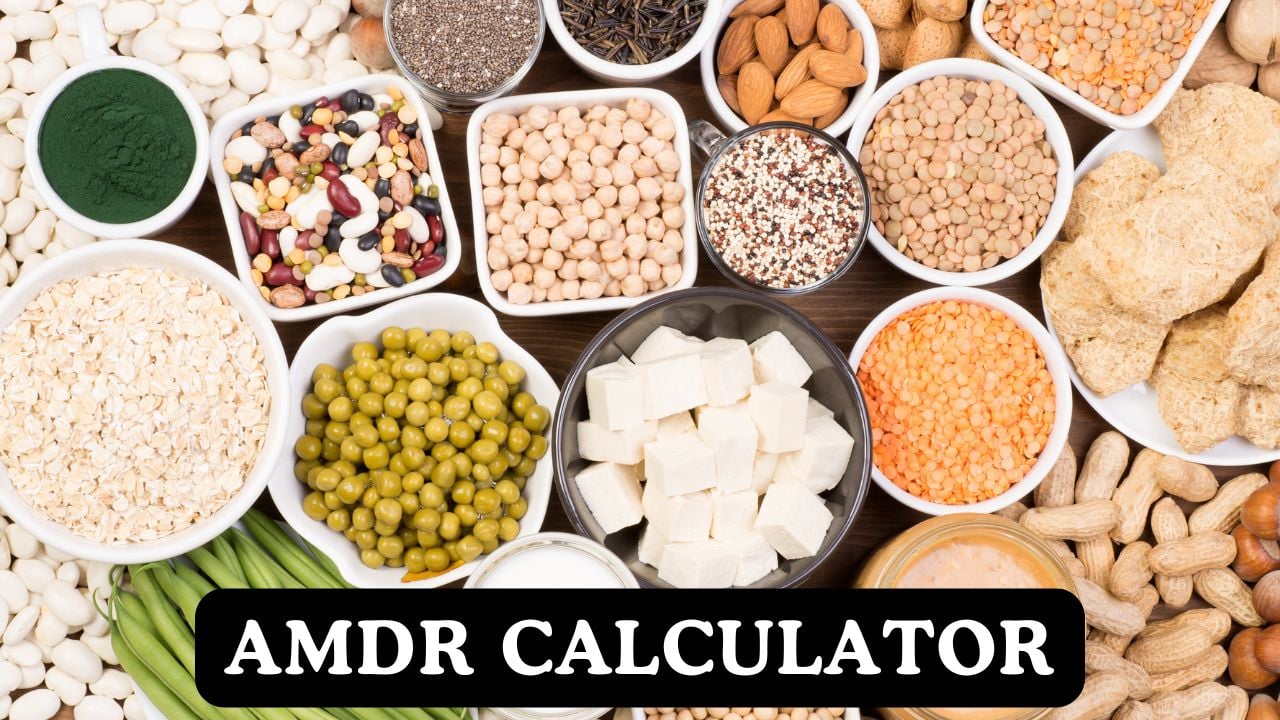AMDR Calculator
Calculate your optimal macronutrient distribution using evidence-based AMDR guidelines for healthy nutrition planning and chronic disease prevention

What is AMDR? Understanding Healthy Eating Guidelines
Simple Guide to AMDR
AMDR stands for Acceptable Macronutrient Distribution Range – basically, it’s a science-backed guide that tells you how much of your daily calories should come from carbs, protein, and fats. Think of it as your nutrition GPS that helps you eat the right balance of foods to stay healthy and energized.
Unlike fad diets that cut out entire food groups, AMDR gives you flexible ranges that work for real life. Whether you’re trying to build muscle with strength training or just want to eat healthier, these guidelines help you make smart food choices without the guesswork.
Why AMDR Matters for Your Health
The World Health Organization and nutrition experts worldwide use AMDR because it’s based on thousands of studies showing what actually keeps people healthy long-term. These aren’t random numbers – they’re carefully calculated ranges that ensure you get all the nutrients your body needs while reducing your risk of heart disease, diabetes, and other health problems.
When you follow AMDR guidelines, you’re not just counting calories – you’re making sure those calories work hard for your body. This approach supports everything from proper muscle recovery after workouts to maintaining steady energy levels throughout the day.
AMDR Guidelines Made Simple
| Age Group | Carbohydrates | Protein | Fats | Key Focus |
|---|---|---|---|---|
| Young Children (1-3 years) | 45-65% | 5-20% | 30-40% | Brain development & growth |
| Kids & Teens (4-18 years) | 45-65% | 10-30% | 25-35% | Growth spurts & activity |
| Adults (19+ years) | 45-65% | 10-35% | 20-35% | Disease prevention & maintenance |
Real-World Translation: For a typical 2000-calorie diet, this means about 225-325g carbs, 50-175g protein, and 44-78g fat daily. The exact amounts depend on your age, activity level, and health goals.
How to Use AMDR in Your Daily Life
🍽️ Practical Meal Planning
Start with Your Plate: Fill half your plate with vegetables and fruits
(carbs), one quarter with lean protein like chicken or beans, and one quarter with whole
grains. Add a thumb-sized portion of healthy fats like avocado or nuts.
Snack Smart: Combine macronutrients in snacks too – apple slices with
peanut butter, Greek yogurt with berries, or whole grain crackers with cheese. This keeps
your energy steady and helps you hit your AMDR targets naturally.
Timing Matters: Spread your protein throughout the day (20-30g per meal) to
support muscle building and recovery, especially if you’re
doing strength training.
🏃♀️ Adjusting for Your Activity Level
Sedentary Lifestyle: Stick closer to the lower end of carb ranges (45-50%)
and focus on fiber-rich options to keep you full. Protein around 15-20% helps maintain
muscle mass even with minimal exercise.
Active Individuals: If you’re doing regular chest workouts or cardio, you can go higher on carbs (55-65%)
to fuel your training. Aim for 20-25% protein to support recovery.
Athletes & Heavy Trainers: You might need the upper end of all ranges,
especially protein (25-35%) if you’re doing intense hamstring and leg training or other demanding
workouts.
Common Questions About AMDR
Can I lose weight following AMDR guidelines?
Absolutely! AMDR isn’t about the total calories you eat, but how you distribute them. For weight loss, create a moderate calorie deficit while staying within AMDR ranges. This ensures you lose fat while keeping muscle mass and energy levels stable. Many people find this approach more sustainable than extreme diets.
What if I’m vegetarian or vegan?
AMDR works perfectly for plant-based diets! You might naturally eat more carbs from fruits, vegetables, and grains, which is fine within the 45-65% range. Focus on protein-rich plants like beans, lentils, quinoa, and nuts to meet your protein needs. Consider slightly higher protein percentages (20-25%) to ensure adequate intake.
How does AMDR compare to keto or low-carb diets?
Keto and very low-carb diets fall outside AMDR ranges, which focus on long-term health and nutrient adequacy. While some people see short-term results with extreme approaches, AMDR provides a sustainable framework that you can follow for life without missing out on important nutrients from whole grains, fruits, and vegetables.
Do I need to track everything I eat?
Not necessarily! While tracking can be helpful initially to understand portions, many people successfully follow AMDR using the “plate method” and mindful eating. Focus on including all three macronutrients at each meal, choose mostly whole foods, and listen to your hunger cues. The calculator helps you understand your targets, but you don’t need to obsess over every gram.
AMDR for Different Health Goals
💪 Building Muscle and Strength
For muscle building, aim for the higher end of the protein range (25-35%) while keeping carbs adequate (45-55%) to fuel your workouts. This supports both shoulder development and overall muscle growth.
Time your carbs around workouts – have some before training for energy and after for recovery. Don’t fear carbs when building muscle; they’re essential for intense training and help your body use protein more effectively for muscle repair and growth.
🏃 Endurance and Cardio Performance
Endurance athletes often need the higher end of carb ranges (55-65%) to maintain glycogen stores for long training sessions. Protein stays moderate (15-20%) but becomes crucial for recovery between training days.
If you’re doing a lot of bodyweight leg exercises or running, focus on complex carbs like oats, sweet potatoes, and whole grains to provide sustained energy without blood sugar spikes.
⚖️ Weight Management
For sustainable weight loss, slightly increase protein (20-25%) to help preserve muscle mass and increase satiety. Keep carbs moderate (45-55%) and choose high-fiber options that keep you full longer.
The beauty of AMDR for weight management is that it prevents the metabolic slowdown often seen with extreme diets. You’re eating enough of everything to keep your body functioning optimally while creating a reasonable calorie deficit.
Foods That Fit AMDR Guidelines
🌾 Smart Carbohydrate Choices (45-65%)
- Whole Grains: Brown rice, quinoa, oats, whole wheat bread
- Fruits: Berries, apples, bananas, oranges
- Vegetables: Sweet potatoes, broccoli, spinach, carrots
- Legumes: Beans, lentils, chickpeas (also provide protein)
Focus on complex carbs that provide fiber, vitamins, and steady energy rather than simple sugars that cause energy crashes.
🥩 Quality Protein Sources (10-35%)
- Lean Meats: Chicken breast, turkey, lean beef, fish
- Plant Proteins: Tofu, tempeh, beans, nuts, seeds
- Dairy: Greek yogurt, cottage cheese, milk
- Eggs: Whole eggs or egg whites
Aim for complete proteins that provide all essential amino acids, especially important if you’re doing triceps and arm workouts.
🥑 Healthy Fat Options (20-35%)
- Nuts & Seeds: Almonds, walnuts, chia seeds, flaxseeds
- Oils: Olive oil, avocado oil, coconut oil (in moderation)
- Fatty Fish: Salmon, mackerel, sardines
- Avocados: Great source of monounsaturated fats
Choose mostly unsaturated fats while limiting saturated fats from processed foods and excessive red meat.
Scientific Research Behind AMDR
Evidence-Based Nutrition Guidelines
WHO and National Academy of Sciences Recommendations
NCBI
Research on AMDR Guidelines –
The AMDR ranges are based on extensive research analyzing the relationship between
macronutrient intake and chronic disease risk. These guidelines represent the optimal
balance for both nutrient adequacy and disease prevention across diverse populations.
Long-term Health Outcomes
Chronic Disease Prevention Studies
Multiple large-scale studies, including the Nurses’ Health Study and Health Professionals
Follow-up Study, have validated AMDR effectiveness for reducing cardiovascular disease, type
2 diabetes, and certain cancers. Following these guidelines consistently shows 15-25%
reduction in chronic disease risk compared to extreme dietary patterns.
⚕️ Important Health Information
This AMDR calculator provides general guidance based on established nutritional science and should not replace personalized medical advice. Individual nutritional needs can vary significantly based on genetics, medical conditions, medications, pregnancy, breastfeeding, and other factors. The calculations are estimates based on population averages and may not reflect your specific metabolic needs. Always consult with healthcare professionals, registered dietitians, or certified nutritionists before making significant dietary changes, especially if you have pre-existing health conditions, food allergies, or are taking medications that may affect metabolism. This tool is for educational purposes and general wellness guidance only.

Manish is a NASM-certified fitness and nutrition coach with over 10 years of experience in weight lifting and fat loss fitness coaching. He specializes in gym-based training and has a lot of knowledge about exercise, lifting technique, biomechanics, and more.
Through “Fit Life Regime,” he generously shares the insights he’s gained over a decade in the field. His goal is to equip others with the knowledge to start their own fitness journey.
